Posted: April 16th, 2014 | Author: Nathan | Filed under: field recording, nature recording
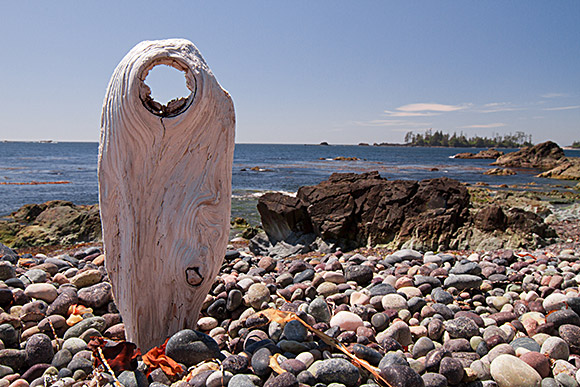
The view west to the Pacific Ocean from Catala Island, British Colombia, Canada.
During my 2013 kayak-camping expedition on the west coast of Vancouver Island, I spent a day by myself photographing and field recording Catala Island. You know you’re in a remote area when you refer to Vancouver Island as “the mainland.”
I found myself on a beach away from the direct Pacific swell, with a nice mix of pebbles and cobbles that made a wonderful rainstick-like tone when the gentle waves receded. (Of course, I’ve posted on recording waves before.)
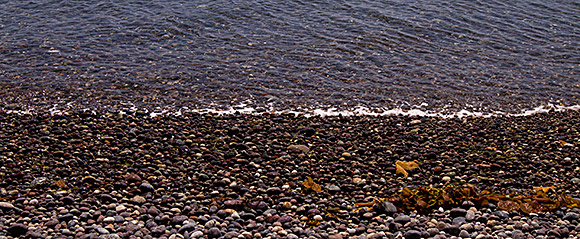
Cobble cobble cobble.
But as isolated as I was, man made sounds still managed to intrude. A lonely acoustic buoy in the distance bleated like a seasick cow on every incoming swell. You may be able to hear this in the background of this recording, faintly, although an aggressive 130Hz high pass filter helped remove the worst of it. Luckily this also removed the distant roar of the sea, actually helping to focus the sound on the small waves that really didn’t have much low-end to them at all.
Many dozens of miles from any road, on an island off another island off the main continent, the sounds of man still pervade. Or perhaps invade.
[soundcloud url=”https://api.soundcloud.com/tracks/140290561″ params=”color=ff5500&auto_play=false&hide_related=false&show_artwork=false” width=”100%” height=”166″ iframe=”true” /]
Tags: ambience, field recording, water | No Comments »
Posted: April 10th, 2014 | Author: Nathan | Filed under: field recording

The MV Uchuck III, passenger vessel and freigher on the west coast of Vancouver island. Kayak for scale.
One of the many reasons this site experienced an almost 1-year hiatus was a self-supported 2-week kayak expedition (check out the video of this amazing trip) on the northwest coast of Vancouver Island. The island is so riddled with deep networks of inlets that it’s actually quite hard to actually get to the exposed west coast. So, at the tiny logging town of Gold River, BC, we put our kayaks on the MV Uchuck III to get motored out to the coast.
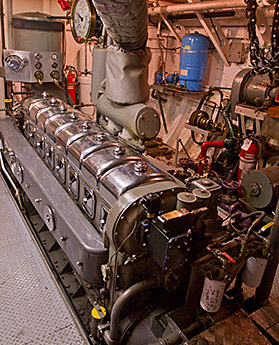
The MV Uchuck III engine room, starboard engine.
The Uchuck III is a lifeline for those that live on the edge of the world, where no roads exist and all travel must be by boat. The Uchuck III brings mail, deliveries, empty dumpsters, groceries, supplies, fish farm provisions, passengers and kayakers from Gold River out to Kyuquot, where we started our trip. It plays a vital role in this extremely remote region, and many generations of skippers and engineers have plied this route. The boat is so storied that there’s even a book about it and its predecessors.
The Uchuck III is a heavily modified World War II minesweeper. The inner double hull and stabilizers were removed to make room for a cargo hold, a crane was added, and the pilot house was moved astern. Its two propellers are powered by one straight-eight diesel engine apiece (a more cranky and surly version of the MV Tutoko, which I rode and recorded in the inlets of New Zealand’s Fiordland), and the skipper can’t control the engines from the pilot house: An actual telegraph is used to relay coded bell rings to the engineer below to take certain actions and “shift gears.” When this thing breaks down, parts need to be machined in Vancouver, from the original construction plans kept aboard.
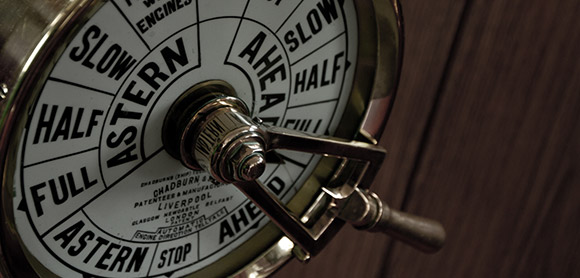
The engine telegraph unit.
Because we were just passing through, essentially, I didn’t get a chance to record too much material, but this post contains some of the perspectives I captured of the ship’s engines and cargo crane. Being a kayak expedition, I only had room for my Sony PCM-D50 recorder, which sucked for nature recording while kayaking…but it was more than sufficient for the loud pounding of the Uchuck III’s twin diesel engines.
[soundcloud url=”https://api.soundcloud.com/tracks/140290347″ params=”color=ff5500&auto_play=false&hide_related=false&show_artwork=false” width=”100%” height=”166″ iframe=”true” /]
Tags: engine, field recording, industrial, machine, mechanical, vehicle, water | 2 Comments »
Posted: December 2nd, 2012 | Author: Nathan | Filed under: field recording, nature recording, sound design
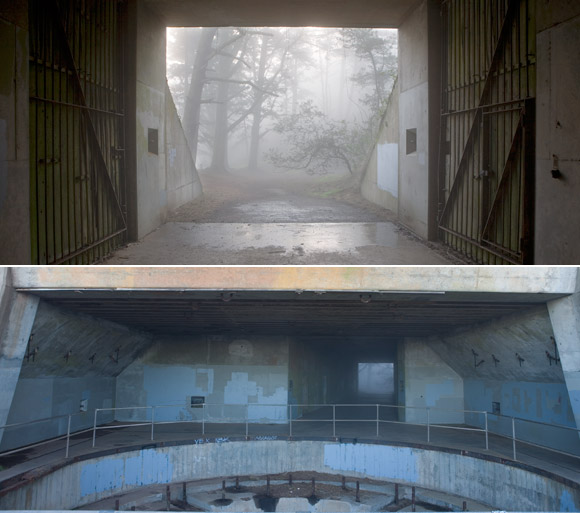
“Construction 129,” a never-completed gun emplacement overlooking the entrance of the Golden Gate, Fort Cronkhite, Marin Headlands, California.
When a winter storm was forecast for the San Francisco Bay Area, I decided to head to the Marin Headlands and try my luck recording bad weather in the abandoned gun emplacements and military fortifications of Fort Cronkhite. I had previously found some great metal sounds at Fort Baker, also in the Headlands, and I was also inspired by Tim Prebble’s high-wind-sub-bass-generator post.
Unfortunately for me, the storm track was slower than predicted, and I wasn’t able to record in peak wind, although some moderate rain started to fall. Such things happen, even with the best of intentions. So, what do you do when your primary plan doesn’t pan out? You reset your expectations and record what you can. I mean, c’mon, I’m in these amazingly evocative ruins! Surely there’s something that’s audibly interesting!
So, I decided to record rain in the tunnels. A recent re-viewing of Ridley Scott’s Prometheus reminded me that tunnels and caverns in films often feature water drops that are drenched in heavy reverb. I pressed the “record” button in several settings and closed my eyes: Was I in the bowels of an ancient spacecraft? The Mines of Moria? The hull of a leaky, empty freighter?
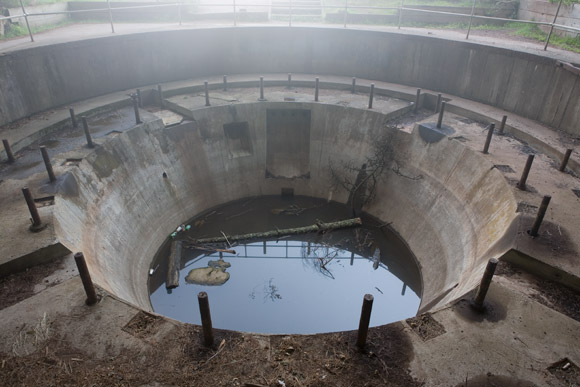
The gun emplacement at Construction 129. No weapon was ever installed.
Occasional wind blasts forced me to enable a high pass filter at 120Hz to try to remove some of the ambient rumble that didn’t help the recording. In addition, there are no fewer than three foghorns in the Marin Headlands, so I had to make an edit every 50 seconds to eliminate the lonely bleat of the Point Bonita lighthouse horn.
There is always something worth recording. You just need to let your disappointment go, reset your expectations with some beginner’s mind, and just start rolling.
[soundcloud url=”http://api.soundcloud.com/tracks/69735256″ params=”auto_play=false&show_artwork=false&color=ee0000″ width=”100%” height=”166″ iframe=”true” /]
[Sennheiser MKH 30/50 mid-side stereo pair into Sound Devices 702 recorder]
Tags: field recording, nature recording, rain, ruins, sound design, sound effects, tunnel, water | 2 Comments »
Posted: February 20th, 2012 | Author: Nathan | Filed under: field recording, nature recording, sound design
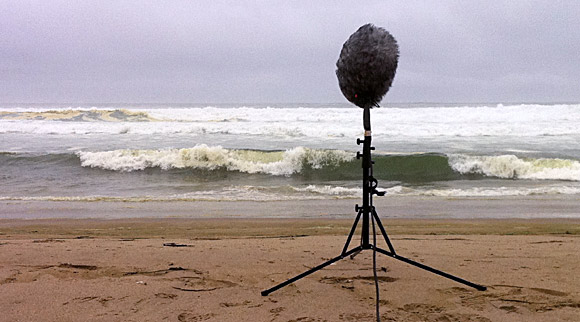
Look carefully: Deep impact zone, short period, wind parallel to the shoreline. Not a good day for recording single waves. So...what is?
It’s easy to get recordings of roaring surf – which can often just sound like constant white noise – but it can be tough to get relatively clean recordings of individual waves. I’ve found that picking a good day and place to record single wave hits are a combination of marine forecasts and location, and that the size of the waves really doesn’t matter.
The only online article I’ve seen that mentions both field recording and marine forecasting has been published by Tim Prebble. In that excellent article, he describes finding gentle-surf days to record his amazing Seal Vocals SFX library. Sometimes finding those small- to moderate-swell days are sometimes the best days to record single wave crashes…but that’s not the only factor.
Single-wave recording conditions are largely defined by a mix of swell, wind, and location.
Swell is due to the large movements of water over great difference; swell is not the same as waves, which are usually wind-driven. Swell is usually forecast based on buoys offshore, and is forecast days in advance. However, I find that 2-day swell forecasts are the most accurate. Swell is defined by wavelength and amplitude, just like audio: Wavelength is is measured in seconds (usually called period), and amplitude (usually called height) is based in feet or meters. Ideally, you want swell with long periods, because that means there’s a greater volume of water moving, but tall swell is also your friend, because that also influences breaking-wave heights at the shore. (Tip: Waves come in “sets” of big and small, between 3 and 8 waves each, depending on if there are multiple wavetrains that are in or out of sync. That means record for far longer than you’d otherwise think in order to get a good range of big vs. small waves over time.)
Getting back to the topic of wind, not all wind is bad (and we all know what wind does to field recordings: huge amounts of badness.) Offshore winds (those that come off of the shore – yes, that is totally confusing!) will might wave faces up longer than they’d be up otherwise, causing a moment of quiet before the wave breaks (or “closes out,” in surf parlance) and a potentially taller wave face. Wind coming onshore (onto the shore from the water) often smears the wave tops and can cause premature toppling…not to mention the fact that the wind will be blowing directly at your microphone capsules. (Tip: You can’t be at the shore without shorebirds, often noisy ones. Bird feeding activity, and therefore noise, may peak before an oncoming storm. Watch the forecast and choose clear weeks with low-pressure days, when it requires more energy to fly, when possible to reduce avian noise. Gulls are complete bastards in this regard!)
Finally, this brings us to location. Some of this is taste: Do you want to record breaking waves against sand, or against rock? Very different sounds will come out of each; bigger crashes will happen on rocks as opposed to sand. But beyond that, know a bit about your location. What direction is the swell and wind coming from, relative to where you’ll be facing? How does the land curve around, creating refraction waves? What is the slant of the land below the shoreline? This last one is especially critical, as the gentler the slope, the bigger the wave. The “impact zone” – where the waves actually break – can be deep or narrow, and a narrower impact zone will generate fewer audible breaking waves at once. Knowing if a beach has a “dumping break” is useful: It makes it terrible to launch from or surf near, but that also means the waves break right at the shoreline, which is far better for audio recording. Just watch out for your gear. (Not a tip, but trivia: Waves always break when the water depth is 1.3x to 1.5x the wave height, as the horizontal energy of the swell gets forced upwards to create breaking-wave heights near shore.)
Never turn your back to the sea. The sea is huge, powerful, indifferent, and above all, unpredictable. Rogue and “sneaker” waves are not legends or myths: They occur regularly, anywhere in the world. Don’t let a recording session end in tragedy.
A final note on technique: If you’re on a beach, angle the mic a bit more downwards than you’d think would be wise, and you’ll get nice sounds of the sand being pulled back as the breaking waves recede back into the ocean. Not always good to have in every recording, but this adds a lot more character. On a beach with fist-sized rocks, this can be especially cool!
I had a recent session at a sandy beach in the Point Reyes National Seashore that exemplified some of the better (but not quite perfect) conditions that I describe above. First, the wind was blowing at 20 knots…but from the opposite direction of the beach I was on, which was backed by hills. That meant delayed wave breaks and being protected from the wind. There was a southerly swell that came right into the dumping-break beach (I can tell the period is averaging 14 seconds by looking at the waveforms of the audio!), so it was all breaking swell and no wind-driven waves. It was a low-pressure day with a long-term clear forecast, and it wasn’t winter, when the masses of migratory birds come through Northern California. Only one swallow’s call made it into the recording.
The recordings aren’t all that dramatic when you consider the breaking waves were only 3-4′ high. But listening to this loud on headphones, eyes closed, I find that the sense of scale is quite exaggerated without an accompanying visual reference…a little Waves LoAir or layering some low-frequency booms can definitely can tip it into cinematically-big breaker territory if desired. However, even in a 90-second clip, there are only three really distinct wave “claps” as the bigger waves close out at the beach.
[Sennheiser MKH 30/50 mid-side stereo pair into Sound Devices 702 recorder]
Tags: field recording, nature, nature recording, ocean, sound design, sound effects, surf, water | 3 Comments »
Posted: January 12th, 2011 | Author: Nathan | Filed under: field recording, sound design

Yes, the Noise Jockey Corporate Yacht follows the Noise Jockey Online Branding and Color Usage Guidelines.
Kayaking on the Whiskeytown Reservoir in Northern California, I was surrounded by motorboats pulling wakeboarders. I wanted to see what all those speedboats sounded like underwater, so I dropped my hydrophone over the side and took a listen (with my field recorder safely under the deck of my kayak, in a dry bag). The inboard engines emitted a clean, high-tech whine with none of the chunky, air-gulping combustion engine sounds we typically hear in the air. “Spaceship,” I instantly thought.
I merged two recordings of these motorboats, each about half a kilometer away, futzed with them just a tad (sorry, my effects chain is lost to the dim mists of time!), and turned it into a loopable drone.
[soundcloud url=”http://api.soundcloud.com/tracks/8232669″ params=”show_comments=true&auto_play=false&color=ee0000″ width=”100%” height=”81″ ]
[Aquarian Audio H2a-XLR hydrophone into a Sound Devices 702 recorder]
Tags: field recording, hydrophone, lake, motorboat, sound design, sound effects, spaceship, water | 4 Comments »
Posted: April 12th, 2010 | Author: Nathan | Filed under: field recording, sound design
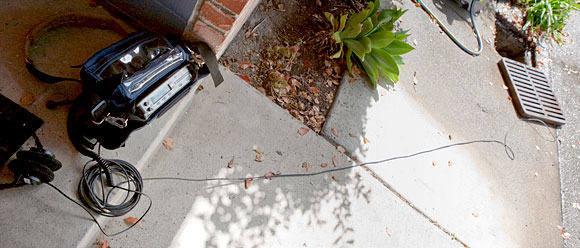
"Sump pump." I mean, ewww. What is "sump," anyway? Sure sounds like it's something in need of pumping!
Our house is very poorly placed on its lot. Since our place is downslope from the street, water runs down the driveway towards the house. Â Thankfully, someone long ago put a pretty good drainage system with an electric pump that pumps the water back to the curb, where it can run to a drainage grate in the street.
In the midst of a week of spring rain, I decided to toss the ol’ hydrophone into the drain box and record the pump, which is activated when a bobber reaches a certain height. The drain box is poured concrete, so it’s acoustically reflective. The pump kicking in is my favorite part, sure to be used for something later on. The big dropoff in volume is where the hydrophone was left high and dry when the water level dropped. Notice how the sound of air bubbles become more pronounced as the water level meets the capsule, and then passes by it. Water turbulence right on the capsule tends to be very loud, as it imparts direct mechanical vibrations to the mic element itself.
[soundcloud url=”http://soundcloud.com/noisejockey/sump-pump” params=”show_comments=true&auto_play=false&color=dd0000″ width=”100%” height=”81″ ]
[Aquarian Audio H2a-XLR hydrophone into Sound Devices 702 field recorder]
Tags: digital audio, field recording, machine, pump, sound design, sound effects, water | No Comments »
Posted: March 19th, 2010 | Author: Nathan | Filed under: field recording, nature recording
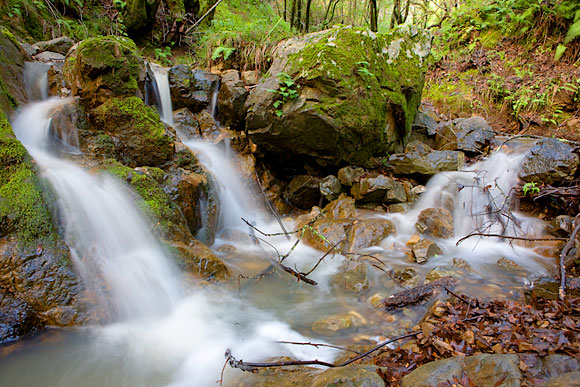
Blackstone Canyon, my local refuge from Bad Things.
I live at the foot of a number of hills that converge into a canyon not five minutes from my house. We have a very Mediterranean climate, so this canyon is dry in the summer. In the winter, the canyon is alive with creeks, streams, and small waterfalls. These winding watercourses have quite varied voices, from deeply resonant hydraulics to burbling, rock-strewn runs. Its sound never ceases to calm me.
This short piece is an aural tour of my local watershed. It crossfades from one water “tone” to another, from the rivulets at the end of the canyon to some of the waterfalls at its head. Of course, the limitations of MP3 encoding sadly adds some warbling and artifacting to the higher frequencies.
When doing this kind of recording, a medium to long boom pole is essential to get nice up-close perspectives without going into the drink yourself.
[soundcloud url=”http://soundcloud.com/noisejockey/voicesofwater” params=”show_comments=true&auto_play=false&color=dd0000″ width=”100%” height=”81″ ]
[Røde NT4 stereo mic into a Sound Devices 702 field recorder]
Tags: canyon, creek, field recording, hiking, nature, outdoors, sound design, travel, water, waterfall | 2 Comments »










